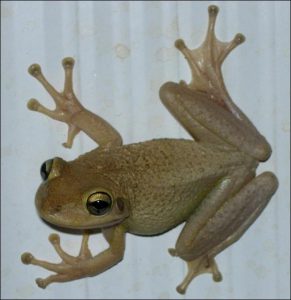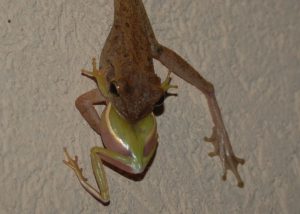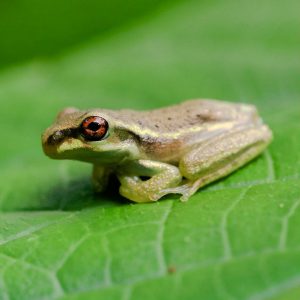 By: Pat Caldwell, UF/IFAS Extension Marion County Master Gardener
By: Pat Caldwell, UF/IFAS Extension Marion County Master Gardener
Have you noticed a decline in native tree frogs and insects in your yard? Have you found relatively large fecal droppings on your patio and exterior house walls and window sills? Have you had large frogs show up in your shower or toilet? If you answered yes to any of these questions, you may be harboring the invasive Cuban tree frog. The Cuban tree frog (osteopilus septentrionalis) is native to Cuba, the Bahamas, and the Cayman Islands. It was accidentally introduced into the Florida Keys in the 1920s and has become an increasing problem for our Florida ecosystem and for humans.
Environmental Impact: Cuban tree frogs are causing a decline in our native tree frogs as they eat the native frogs as well as lizards and small snakes. They can also invade nesting boxes designed for birds.

Human Impact: The frogs also secrete noxious mucus that can cause intense burning in the eyes, allergy-like reactions and even asthmatic attacks. They have also been known to cause increased salivation and seizures in pets. The frogs have invaded houses causing plumbing problems such as clogged drains and toilets. They can also invade power boxes where they can cause power outages.
Due to their dramatic impact on the Florida environment, the recommendation from the University of Florida is to capture and humanely euthanize the frogs. It is very important that you correctly identify the Cuban tree frog so that you do not euthanize a Florida native species. For tips and phots on correctly identifying the Cuban tree frog, go to the UF/IFAS Wildlife website at http://ufwildlife.ifas.ufl.edu/cuban_treefrog_inFL.shtml. If you do not wish to euthanize the frogs yourself, you can capture them and take them to your local extension office. It is illegal to release these frogs into the wild even though they are legally sold in Florida.
Identifying a Cuban Tree Frog:
The identification can be tricky as they come in many colors and sizes. Here are some helpful tips for identifying them:
- Cuban tree frogs are generally larger than native frogs. They range from 1-6 inches. Any tree frog over 2½ inches is not

Juvenile Cuban tree frog a native frog
- They have very bumpy and warty skin
- Their armpits and groin may have a pale yellow color
- Their color is often beige or white, but can also be creamy white, green, light brown, yellow or dark brown
- Juvenile frogs may have stripes down their sides, red eyes, and blue bones that can be seen through the skin on their underside
Capturing and Euthanizing the Cuban Tree Frog:
Wear gloves or use a plastic bag to catch the frog. Apply 20% benzocaine ointment or spray to the belly or back of the frog and wait 10-15 minutes. Benzocaine is available in first aid sprays, sunburn relief products and toothache ointments. Benzocaine puts the frog into a coma. At that point, place the frog on a plastic bag and place in the freezer overnight. You can then dispose of the frog in the trash. It may seem harsh, but by eliminating these fugitives, you are protecting the Florida natives and preventing potential problems to its residents. Make sure to wash your hands thoroughly to prevent any exposure to the toxic secretions.
Prevention of Breeding:
The Cuban tree frogs can lay up to 1,000 eggs per year and multiply rapidly. You can also help the environment by ensuring that there is no standing or stagnant water in your yard. This will also decrease the mosquito population. Keep pet water bowls and birdbaths clean every day with fresh water. Survey your property for signs Cuban Tree
Frog infestation:
If you would like to be more involved in the reporting and capture of these fugitives, you can become a “Citizen Scientist” More information can be found at http://ufwildlife.ifas.ufl.edu/citizen_sci.shtml. Let’s all work together to catch these fugitives and protect Florida for the future!
If you have questions or concerns, check with the Master Gardeners at 671-8400 for additional information that you may need.
 1
1

